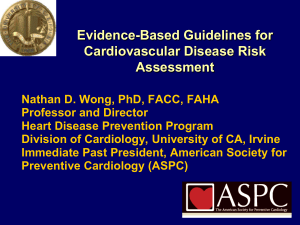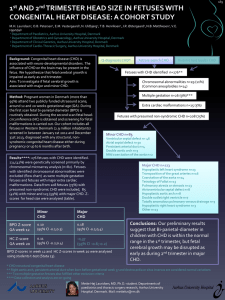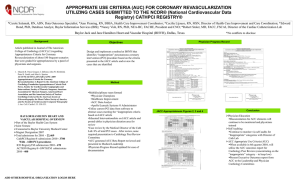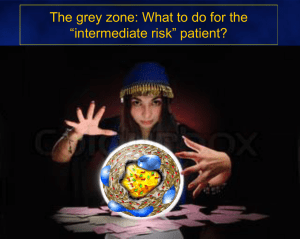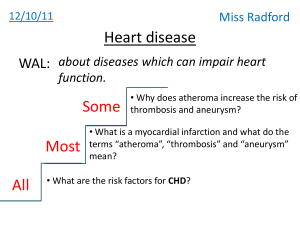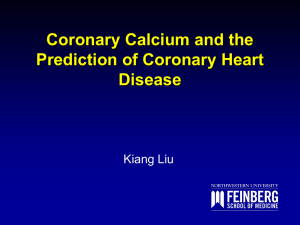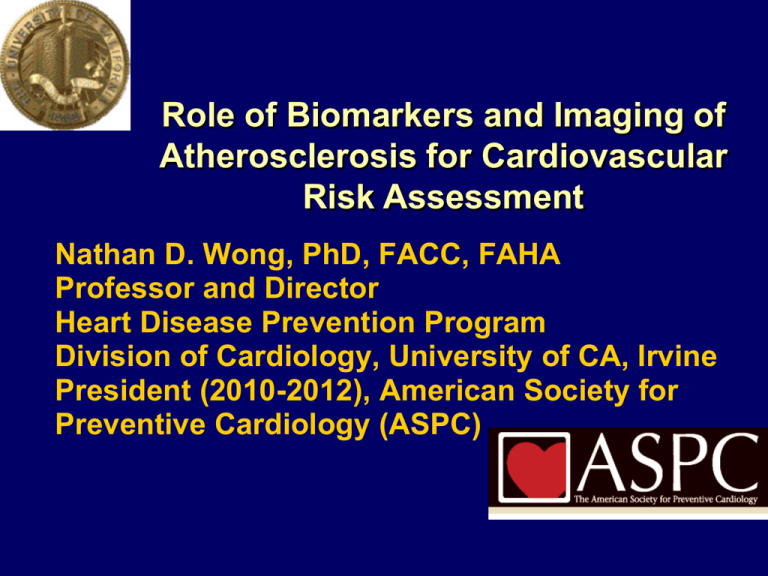
Role of Biomarkers and Imaging of
Atherosclerosis for Cardiovascular
Risk Assessment
Nathan D. Wong, PhD, FACC, FAHA
Professor and Director
Heart Disease Prevention Program
Division of Cardiology, University of CA, Irvine
President (2010-2012), American Society for
Preventive Cardiology (ASPC)
Presenter Disclosures
• Consultant for Re-Engineering Healthcare, Inc.
• Research support through University of
California, Irvine from Merck and Bristol Myers
Squibb
• Advisory/board consultant for Merck
Concept of cardiovascular “risk
factors”
Age, sex, hypertension, hyperlipidemia, smoking, diabetes,
(family history), (obesity)
Kannel et al, Ann Intern Med 1961
Framingham 10-year Total CVD Risk Algorithm
(D’Agostino et al 2008)
Low risk <10%, Intermediate risk 10-20%, High Risk >20%
The Detection Gap in CHD
“Despite many available risk assessment
approaches, a substantial gap remains in the
detection of asymptomatic individuals who
ultimately develop CHD”
“The Framingham and European risk scores…
emphasize the classic CHD risk factors…. is only
moderately accurate for the prediction of shortand long-term risk of manifesting a major coronary
artery event…”
Pasternak and Abrams et al. 34th Bethesda conf. JACC 2003; 41:
1855-1917
Not all individuals with coronary
heart disease have traditional risk
factors
3 RF
9%
4 RF
1%
0 RF
19%
2 RF
28%
1 RF
43%
Khot et al. JAMA 2003
How Good Is NCEP III in Identifying Patients at Risk for
MI
• 1998 – 2002. 222 patients with 1st acute MI, no prior CAD,
no DM. Men <55 y/o (75%), Women <65. 40% hypertensive
• What was NCEP risk before the MI?
•
Would they have received statin therapy by NCEP criteria?
75% would not qualify for statin Rx
Akosah JACC 2003:41 1475-9
Criteria required for a good screening test
• Provides an accurate determination of the
likelihood that an asymptomatic person has the
condition (accuracy)
• Reproducible results (reliability)
• Detect individuals where early intervention is
likely to have a beneficial impact
• Should provide incremental value to risk
predicted by office-based risk assessment
Redberg and Vogel et al., 34th Bethesda Conf. JACC 2003; 41: 1855-1917
Incremental Value and Reclassification
• Do newer markers and measures of
subclinical disease improve risk prediction,
e.g., by improvement in C-statistic from
ROC analyses?
• Can new markers accurately stratify
individuals into higher or lower risk
categories?
• Will such reclassification change how
these individuals are treated?
• Net Reclassification Index (NRI)
Risk Reclassification with CRP
Framingham Offspring Experience
Reclassification
Characteristic
Color
Code
Cases
Non
Cases
Up
14%
2%
Down
6%
1%
Difference
8%
1%
Net
7%
Reclassification
The NRI is the difference in proportions moving up and
down among cases vs controls, or NRI = [Pr(up | case) –
Pr(down | case)] – [Pr(up | control) – Pr(down | control)].
Wilson Circulation: CV Care & Outcomes 2008
JACC Nov. 15, 2010
Biomarkers of Interest
• Inflammatory
– Hs-CRP
– LpPla2
• Lipid
– ApoB, LDL-P, Lp(a), and
LDL/HDL subclasses
• Cardiac
– BNP, Troponin,
Myeloperoxidase
• Renal
– GFR, NGAL
hs-CRP as a Risk Factor For Future CVD : Primary Prevention
Cohorts
Kuller MRFIT 1996
CHD Death
Ridker PHS 1997
MI
Ridker PHS 1997
Stroke
Tracy CHS/RHPP 1997
CHD
Ridker PHS 1998,2001
PAD
Ridker WHS 1998,2000,2002
CVD
Koenig MONICA 1999 CHD
Roivainen HELSINKI 2000
CHD
Mendall CAERPHILLY 2000
CHD
Danesh BRHS 2000
CHD
Gussekloo LEIDEN 2001
Fatal Stroke
Lowe SPEEDWELL 2001
CHD
Packard WOSCOPS 2001
CV Events*
Ridker AFCAPS 2001
CV Events*
Rost FHS 2001
Stroke
Pradhan WHI 2002
MI,CVD death
Albert PHS 2002
Sudden Death
Sakkinen HHS 2002
MI
0
Ridker PM. Circulation 2003;107:363-9
1.0
2.0
3.0
4.0
5.0
6.0
Relative Risk (upper vs lower quartile)
Risk Factors for Future Cardiovascular Events: WHS
Lipoprotein(a)
Homocysteine
IL-6
TC
LDLC
sICAM-1
SAA
Apo B
TC: HDLC
hs-CRP
hs-CRP + TC: HDLC
0
1.0
2.0
4.0
6.0
Relative Risk of Future Cardiovascular Events
Ridker et al, N Engl J Med. 2000;342:836-43
CRP Improves Net Reclassification Index
• From the Physicians Health Study: hs CRP
and parental history improved risk prediction
5.3% overall and 14.2% for patients at
intermediate risk by traditional risk scores
(both P<0.001) (Ridker et al., Circulation
2008)
• Framingham Heart Study: hs-CRP improved
prediction of cardiovascular disease by 5.6%
(P=0.014) and of coronary heart disease by
11.8% (P=0.009) (Wilson et al. Circulation:
Cardiovascular Quality and Outcomes 2008).
HMG-CoA Reductase Inhibitor Evidence:
Primary Prevention
Justification for the Use of Statins in Prevention: An
Intervention Trial Evaluating Rosuvastatin (JUPITER)
Cumulative incidence of CV
death, MI, CVA, hospitalization
for unstable angina, and
arterial revascularization
0.00
0.04
0.08
17,802 men (>50 years) and women (>60 years) with LDL-C <130 mg/dL
and hs-CRP >2 mg/L randomized to rosuvastatin (20 mg) or placebo for up
to 5 years*
Rosuvastatin
Placebo
44% RRR
P<0.00001, NNT=25
0
1
2
Follow-up (years)
3
4
A statin provides benefit in those with elevated hs-CRP levels
CV=Cardiovascular, LDL-C=Low density lipoprotein cholesterol
*The study was stopped prematurely after 1.9 years
Ridker PM et al. NEJM 2008;359:2195-207
C-Reactive Protein Recommendations
• Class IIa: men >=50 years or women >=60 years of age
with LDL-C<130 mg/dl, not on lipid-lowering therapy, HRT,
or immunosuppressant therapy, without CHD, DM, CKD, or
other contradindications, can be useful in the selection of
patients for statin rx (Level of Evidence B)
• Class IIb: asymptomatic intermediate risk men <=50 years or
women <=60 years of age measurement may be reasonable
for cardiovascular risk assessment
• Class III: asymptomatic high risk adults or lower risk
men<50 or women<60 years of age, CRP not
recommended
• May help guide intensity of therapy in those at intermediate
risk or with CHD and to a lesser extent in those with a family
history of premature CHD
ACCF/AHA Guideline for Assessment of Cardiovascular Risk in Asymptomatic
Adults, Circulation 2010, NLA Expert Panel, J Clin Lipidology Oct 2011
Lp-PLA2 and CRP: Two Independent and
Distinct Inflammatory Markers
CRP
Lp-PLA2
Marker of systemic inflammation
Marker of vascular inflammation
Predominantly produced by liver in
response to inflammatory reactions
– acute phase reactant
Produced by macrophages
Specific role in CVD emerging
Likely involved in initiation of
early stage of the vascular
inflammatory process
Predicts risk in healthy
individuals
Minimal biovariability
Not affected by other
inflammatory conditions
Identifies a different at-risk
patient population from LpPLA2
Identifies different at-risk
patient population from CRP
Lp-PLA2 and vascular disease:
metaanalysis of 32 studies (n=79,036)
LpPLA2 Studies Collaboration (2010) Lancet 375; 1536-1544
Stroke Hazard Ratio
Association of Lp-PLA2 and hs-CRP with
Stroke
95% CI 3.01–24.92,
p<0.001
8.66
4.69
10
2.64
4.26
High(422)
3.47
3.18
5
4.40
2.80
1.00
High
Medium
Low
(>3)
(1–3)
(<1)
0
hs-CRP, mg/L
Medium(310–422)
Low
(<310)
LpPla2 Recommendations
• Class IIb – Might be reasonable for
cardiovascular risk assessment in
intermediate risk asymptomatic adults (Level
of Evidence B)
• Selected higher risk pts (CHD, family hx
premature CHD)
• Not yet recommended for on-treatment
management decisions since no randomized
trials yet showing efficacy of intervention
ACCF/AHA Guideline for Assessment of Cardiovascular
Risk in Asymptomatic adults, Circulation 2010, NLA Expert
Panel, J Clin Lipidol Oct 2011
BNP as a Predictor of Risk in Asymptomatic
Adults: The Framingham Heart Study
Wang et al., NEJM 2004
B-Type Natriuretic Peptides and CVD
Risk (Circulation 2009; 120: 2177-2187)
• Meta-analysis of 40 long-term
prospective studies involving 87,474
patients.
• Highest vs. lowest tertile, adjusted
RR=2.82 (2.40-3.33).
• RRs similar for BNP (2.89) or NT-pro
BNP (2.82) and in general populations
(2.68), increased risk factors (3.35), and
stable CVD (2.60).
• Modest improvements in risk
discrimination (increase in C-statistic of
0.01 to 0.1).
Natriuretic Peptides Recommendation
• Class III: No benefit
– Measurement of natriuretic pepetides is
not recommended for CHD risk
assessment in asymptomatic adults
(Level of Evidence B)
ACCF/AHA Guideline for Assessment of Cardiovascular
Risk in Asymptomatic Adults, Circulation 2010
The Future of Cardiac Biomarkers
• Many experts are advocating the move
towards a multimarker strategy for the
purposes of diagnosis, prognosis, and
treatment design
• As the pathophysiology of ACS is
heterogeneous, so must be the diagnostic
strategies
A Multimarker Approach Should Focus
on Multiple Mechanisms / Pathologies
Circulation 108: 250-252
Additional Utility of Multiple Biomarkers for Prediction
of Death: FHS
ROC Curves for Death
Adj HR Death per
1 SD
BNP
1.40
CRP
1.39
Urine Alb/Cr
1.22
Homocysteine
1.20
Renin
1.17
SCORE
4.08*
0.82
Sensitivity
Biomarker
0.80
* HR for highest quintile v. lowest 2 quintiles
1-Specificity
Wang TJ et al. NEJM 2006;355:2631
Multiple Biomarkers for Prediction of
CV Death in Older Adults
Variables
C statistic
P value
Established risk factors
0.66
Ref
+ cTnI
0.72
0.002
+ NT-proBNP
0.75
<0.001
+ cystatin C
0.69
0.07
+ CRP
0.69
0.07
+ all biomarkers
0.77
<0.001
Zethelius B et al. N Engl J Med 2008;358:2107-2116
Results of the biomarker score including troponin I, NTbroBNP, and C-reactive protein in the Belfast PRIME Men
validation cohort
Blankenberg, S. et al. Circulation 2010;121:2388-2397
Carotid B-Mode Ultrasonography
• Measurement of intimal medial thickness
• Non-invasive, inexpensive, no radiation
• Well-established as an indicator of cardiovascular
risk from epidemiologic studies
• Published clinical trials on utility of carotid IMT as
measure of progression of atherosclerosis and
effects of therapy
• Accuracy of assessments depends on experience
of those interpreting scans
• ACCF/AHA 2010 Guideline: CIMT
measurement may be reasonable for CV risk
assessment in asymptomatic adults at
intermediate risk (Class IIa-B)
Cardiovascular Health Study: Combined
intimal-medial thickness predicts total MI
and stroke
Cardiovascular Health Study (CHS) (aged 65+): MI or stroke rate 25% over 7 years in
those at highest quintile of combined IMT (O’Leary et al. 1999)
Change in CIMT (mm +/- SEM)
ARBITER 2: Primary Endpoint
Carotid IMT Across 12 Months
0.07
CIMT at 12 months
0.06
• Statin vs ER niacin +
statin P = 0.08
0.05
68% decrease in progression
• Intent-to-treat analysis
of statin vs. ER niacin +
statin P = 0.048
0.04
0.03
• Non-Insulin resistant
pts only: statin vs. ER
niacin P = 0.026
0.02
0.01
0
ER Niacin
Placebo
Taylor AJ, et al. ARBITER 2: A double-blind, placebo-controlled study of extended-release
niacin on Atherosclerosis progression in secondary prevention patients treated with statins.
Circulation. 2004
Ankle-brachial blood pressure (ABI)
– Simple noninvasive test to confirm lower extremity
peripheral arterial disease (PAD)
– Uses Doppler probe to measure SBP in brachial,
posterial tibial, and dorsalis pedis arteries
– ABI <0.9 in either leg is diagnostic of PAD
– ACCF/AHA 2010 Guideline: Measurement reasonable
for CV risk assessment in asymptomatic adults at
intermediate risk (IIa-B)
– Test most likely to be positive in those over 50 who have
other risk factors
MEASUREMENT OF ABI:
•The higher of the SBP measures taken in each arm is the
denominator for the ABI calculation for each leg.
•The higher of the two pressures in each ankle (from posterior tibial
and dorsalis pedis arteries) forms the numerator for the left and
right ABI, respectively.
Ankle Brachial Index as a Predictor of
Cardiovascular Mortality in the CHS Study
Newman A et al ATVB
ABI and Total Mortalty
(ABI Collaboration, JAMA 2008)
Reclassification of Risk Category from
ABI (ABI Collaboration, JAMA 2008)
19% of men and 38% of women would be reclassified in
their risk category from addition of ABI.
Arterial Stiffness and CVD Events in the
Framingham Heart Study (Mitchell et al., Circ. 2010)
After adjustment for risk factors, higher carotid-femoral
pulse wave velocity (PWV) was associated with a 48%
increase in CVD events over 7.8 years of follow-up.
Arterial Stiffness and CVD Events
(Mitchell et al., Circulation 2010)
• Addition of PWV resulted in upward reclassification of
14.3% of those with CVD events and downward
reclassification of 1.4% of those without events (net
reclassification of 15.7%, p=0.03).
• Integrated discrimination improvement of 0.7% (p<0.05);
0.8% (p=0.02) in the intermediate risk group.
• No relation to events for carotid-radial PWV,
augmentation index, and central pulse pressure or pulse
pressure amplification.
• ****************************************************************
• ACCF/AHA 2010 Guideline: Measures of arterial
stiffness outside of research settings are not
recommended for CV risk assessment in
asymptomatic adults (Class III-C)
Coronary Calcium and Atherosclerosis:
Pathology Evidence
• Coronary calcium invariably
indicates the presence of
atherosclerosis, but
atherosclerotic lesions do not
always contain calcium (1-3).
• Calcium deposition may occur
early in life, as early as the
second decade, and in lesions
that are not advanced (4-5).
• Correlates with plaque burden;
highly sensitive for
angiographic disease
1) Wexler et al., Circ 1996; 94: 1175-92, 2) Blankenhorn and Stern, Am J Roentgenol 1959;
81: 772-7, 3) Blankenhorn and Stern, Am J Med Sci 1961; 42: 1-49, 4) Stary, Eur Heart J
1990; 11(suppl E): 3-19, 5) Stary, Arteriosclerosis 1989; 9 (suppl I): 19-32.
Cumulative Incidence of Any Coronary
Event: MESA Study
(Detrano et al., NEJM 2008)
Risk Factor-Adjusted Hazard Ratios by
Coronary Calcium Score: MESA Study
(Detrano et al., NEJM 2008)
Area Under Curve for Risk Factors Alone
and Risk Factors Plus CAC by Ethnic Group:
MESA Study (Detrano et al., NEJM 2008)
Net Reclassification of CHD Risk by
Coronary Calcium: MESA Study
(Polonsky et al., JAMA 2010)
The addition of CAC to
models with age, gender,
ethnicity and risk factors
alone resulted in net
reclassification of 0.25
(p<0.001); 23% of those
with events were
reclassified as high risk
and 13% without events
were reclassified as low
risk.
Annual CHD Event Rates (in %) by Calcium Score Events by
CAC Categories in Subjects with DM, MetS, or Neither Disease
(Malik and Wong et al., Diabetes Care 2011)
Coronary Heart Disease
4
Annual
CHD
Event
Rate
4
3.5
3
2.5
2
1.5
1
0.5
0
3.5
1.9
1.5
0.4
0.8
0.2
0.1
0
2.1
0.4
1-99
2.2
1.3
DM
MetS
Neither MetS/DM
100-399
400+
Coronary Artery Calcium Score
ACCF/AHA 2010 Guideline: CAC Scoring for CV risk assessment in
asymptomatic adults aged 40 and over with diabetes (Class IIa-B)
Median Annual Progression of CAC by Presence of
MetS / DM: MESA (n=2735 with CAC>0 at baseline)
(Wong et al., JACC Cardiovasc Imaging 2012)
Progression of CAC and CHD Events in Persons with
Metabolic Syndrome, Diabetes, and Neither Condition
(Wong et al., JACC Imaging, April 2012)
Indications for CAC Assessment
(Greenland et al., ACCF/AHA Guideline for Assessment of
Cardiovascular Risk in Asymptomatic Adults (Circulation, 2010)
•
CV risk assessment in asymptomatic adults at
intermediate risk (10-20% 10-year risk) (Class
IIa, Level of Evidence B)
•
CV risk assessment in persons at low to
intermediate risk (6-10% 10-year risk) (Class IIb,
Level of Evidence B)
•
CV risk assessment in asymptomatic adults
with diabetes (Class IIa-B)
•
Persons at low risk (<6% 10-year risk) should
not undergo CAC measurement for CV risk
assessment (Class III, Level of Evidence B)
CAC Screening Can Identify Persons Who May Need
Pharmacotherapy Not Identified By Traditional Risk
Asssessment: Proportion of Not Qualifying For
Pharmacotherapy by NCEP-III across Increasing CACS
100
90
89
80
74
70
65
59
60
50
40
CCS=0
CCS 1-99
CCS 100-399
CCS400
Nasir, Michos. Blumenthal, Raggi JACC 2005;193101936
Does coronary artery screening by electron
beam computed tomography
motivate potentially beneficial lifestyle behaviors?
In 703 men and women aged 28-84 who received scanning for
coronary
calcium by EBCT, calcium score remained independently
associated with:
new aspirin usage
new cholesterol medication
consulting with a physician
losing weight
decreasing dietary fat
…but also increased worry
…..potentially important risk-reducing behaviors may be
reinforced by the knowledge of a positive coronary artery scan,
independent of preexisting coronary risk factor status.
Impact of Coronary Artery Calcium Scanning on
Coronary Risk Factors and Downstream Testing
(Rozanski, Berman, Wong et al. JACC 2011)
• We compared the clinical impact of conventional
risk factor modification to that associated with the
addition of coronary artery calcium (CAC)
scanning.
• 2,137 volunteers underwent CAC scanning or did
not undergo CAC scanning before risk factor
counseling.
• Primary end point was 4-year change in coronary
artery disease risk factors and Framingham Risk
Score; also examined medical resource utilization
Eisner Study Results
– Compared with the no-scan group, the scan group
showed improvement in systolic blood pressure (p
= 0.02) and LDL-C (p = 0.04), and waist circum in
those with increased abdominal girth (p = 0.01).
– Increase in Framingham Risk Score (FRS) in the
no-scan group, but no change in the scan group
(0.7 ± 5.1 vs. 0.002 ± 4.9, p = 0.003).
– Within the scan group, increasing baseline CAC
score was associated with an improvement in risk
factors and FRS (p<0.01).
– Downstream medical testing and costs in the scan
group were similar to the no-scan group.
CT Angiography:
Will total or noncalcified plaque
burden predict CHD
risk over standard
risk factors or
coronary calcium???
3D vessel probe of the Left Main and LAD coronary artery. Curved MPR images are automatically
rendered and quantify this LAD lesion at 48% diameter stenosis. SUREPlaque software is used to
determine plaque burden and a vessel remodeling index at this lesion. Images courtesy of Courtesy
of Toshiba America Medical Systems and Vital Images SUREPlaque and University of California
ACS
Positive remodeling (+), Soft plaque (+),
Fibrous plaque (+),
Calcification (-)
LAD
Motoyama et al. JACC 2007;50:319-26
% of Patients Subsequently Resulting in ACS by
CCTA Plaque Features (F)
25
20
Adverse features (F):
positive remodeling
low-attenuation plaques
15
% with events
10
5
0
nl
0
1F
2F
(0/167) F(4/20) (1/27) (10/45)
1,059 pts with CCTA followed up for 27 ± 10 mo
ACS developed in 15 patients.
None had >75% stenosis in the culprit lesion at time of CCTA
Motoyama et al. JACC 2009;54:49-57
All-Cause Mortality from CCTA Findings
in the CONFIRM Registry (Min et al.,
JACC 2011)
• 24,775 pts underwent >=64 detector CCTA
• After 2.3 years follow-up 404 deaths occurred
• HR for death was 2.6 for obstructive and 1.6 for
nonobstructive (both p<0.01)
• HR by no of obstructive vessels was 1.6 for
nonobstructive, 2.0 for 1 vessel, 2.9 for 2 vessels,
and 3.7 for 3+ vessels (all p<0.01)
• Absence of CAD by CCTA was associated with
low incident death rates (0.28%).
• Hazards for death from multiple vessel CAD were
higher for younger persons and women.
Quantitative MRI Measurements
Post-CE T1
*
Atherosclerotic
T2
PD plaque burden:
TOF
lumen, wall & outer wall volume in
mm3
wall/outer wall ratio
wall thickness in mm
Tissue characteristics:
Post-CE T1
*
volume in mm3 & composition in %
of
T2
PD
TOF
lipid, loose matrix, calcium,
hemorrhage and fibrous tissue
Plaque integrity evaluation:
Cap - rapture, thin, and thick (quantified)
Ulceration - no, yes and size
Thrombus - no, yes and size
MR Imaging of Carotid Plaque Composition During
Lipid-Lowering Therapy A Prospective Assessment
of Effect and Time Course (Zhao XQ et al., JACC
Imaging Sept 2011)
• Subjects with coronary or carotid artery disease,
apolipoprotein B ≥120 mg/dl were randomly assigned to
atorvastatin or to atorvastatin-based combination therapies
with appropriate placebos for 3 years.
• All subjects underwent high-resolution, multicontrast bilateral
carotid MRI scans at baseline and annually for 3 years.
Images were analyzed for quantification of wall area and
plaque composition.
• The 33 subjects with measurable lipid-rich necrotic core
(LRNC) at baseline had a significant reduction in plaque lipid
content
– LRNC volume decreased from 60.4 ± 59.5 mm(3) to 37.4
± 69.5 mm(3) (p < 0.001)
– %LRNC (LRNC area/wall area in the lipid-rich regions)
from 14.2 ± 7.0% to 7.4 ± 8.2% (p < 0.001)
ACCF / AHA Nov 2010 Guidelines for Risk
Assessment in Asymptomatic Persons
•
•
•
•
•
•
•
•
•
•
Resting ECG in those with HTN/DM (IIa – C)
Transthoracic Echo in those with HTN (IIb – B)
Stress Echocardiography (III – C)
Myocardial Perfusion Imaging (IIb-C for those with DM or
strong family hx, or CAC>=400)
Carotid IMT for intermediate risk (IIa – B)
Brachial/Peripheral FMD (III – B)
Arterial Stiffness (III – C)
Ankle Brachial Index for intermediate risk (IIa – B)
Coronary Calcium Screening (IIa – B for 10-20% 10-year
risk or DM, IIb – B for 6-10% 10-year risk, III – B for <6%
risk)
Coronary CT Angiography, MRI Plaque Imaging (III – C)
We cannot concede the need to better identify
susceptible individuals for targeted intervention
Bio
Genetic
Markers markers
Current
Algorithms
Imaging
Summary
• Screening tests using biomarkers or for subclinical
atherosclerosis should provide incremental risk
prediction for CHD events over global risk
assessment
• Guidelines suggest intermediate risk subjects may
be suitable for such screening that may help
identify those needing more aggressive risk factor
intervention.
• However, it is not known whether screening for
biomarkers or subclinical atherosclerosis will
ultimately lead to long-term clinical benefit and save
lives.
Braunwald’s Preventive
Cardiology Now Available
www.heart.uci.edu
Join the ASPC at
www.aspconline.org

